Archive for ‘NAPO Conference’ Category
Presto, Change-o! NAPO Expo 2013 Shape-shifting Organizing Products #2: Ampad SimpleSort Crossover
Each year at the National Association of Professional Organizers annual Conference and Expo, one of our favorite booths to visit is Esselte’s. The Esselte family, famous for Pendaflex and Oxford filing and office products, has added Ampad to the brood. Oh, but this is not your fourth grade teacher’s Ampad, with the same old boring notepads. Ampad has come a long way, Baby!
The Collating Conundrum
Longtime Paper Doll readers at the old site know that I’m a fan of legal pads. My preference is purple, because it’s easy to spot amid any cluttered client environment, but pink or blue pads work just as well.
Everyone else has yellow or white notepads, so by keeping to the rich pastels, I’m more likely to spot my pad quickly, and in twelve years haven’t (yet) left a client site without it safely tucked in my bag.
The key to making perforated-at-the-top legal pads work for you is to make sure you keep similar items together. You can try to select different pads for different tasks (home improvement, individual work projects, party planning), and label the front page so you don’t mix up the pads, but it’s easy to be thrown off the mark. For example, one day last week, I was taking notes on a live teleclass when I got interrupted by a telephone call from a prospective client. Weighing the value of finishing the teleclass vs. taking the prospect call and later listening to the recording of the teleclass, I opted for the latter. Quickly, I flipped to the next page to take notes on my conversation. Later that night, when the teleclass recording was available, I started with a fresh page, but that still meant my papers — on the pad — were jumbled.
Eventually, I will tear off the pages for the teleclass and stack them with my Continuing Education Unit documentation for my next BCPO recertification. And the prospect’s page will either go in his client folder, if I’m hired, or a mass prospect folder, if not. But until I know, it’ll stay on the pad, sandwiched between unrelated items, and not exactly easily located. (Yes, even professional organizers may grab the wrong notepad sometimes.)
There are suitable alternatives to perforated legal pads, like three-ring binders, such as the Staples Better Binder we discussed yesterday. With a binder, you use loose-leaf paper, and sorting is as simple as opening the rings and moving any given sheet behind an appropriate divider. Just sort all your papers by (sub)category and group similar items together.
But binders are bulky. They’re great for storage, but it’s hard to take notes in a binder when you are in a classroom or lecture setting and don’t have a desk on which to spread out your notetaking paraphernalia. Experience has taught me that my left-handed clients can’t take notes in ringed binders at all. Sure, you can take notes on loose-leaf papers and only insert them in binders when you’re done with the course or session, but then you need to carry a clipboard or other hard surface, since there’s no cardboard or other type of backing to create a writing surface.
You can use spiral notebooks, of course, but then you’re faced with the same problem as with perforated pads — no way to collate the papers until you remove them from the notebook. Worse, you’re left with raggedy pages and the detritus from edges torn away from the spiral wire…unless you get the spiral notebooks that also have perforations. A spiral in a spiral, this is.
Introducing The Ampad SimpleSort Crossover Writing Pad.
At the top, instead of holding the papers together with glue above a perforation, as you usually see with legal pads, there’s a hard plastic shell (Ampad calls it a “binder clip”) that flips upward to reveal little nubs. The shell snaps down over the nubs, holding the individual sheets in place. The two-hole-punched papers are perforated, so you can tear them off whenever you like, but for use on the pad, you can play musical chairs.
If, over the course of a day, you take notes on chemistry, math and literature (or are writing pages on your marketing plan, budget and To Do list), just flip-up the plastic shell, lift out the papers and enclosed section dividers, 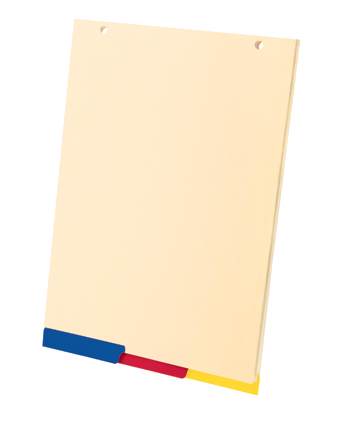
shuffle everything to your preference, and insert the individual paper pages wherever they belong. Simple. Sorted.
For you visual learners, here’s a video direct from Ampad to get a sense of how the SimpleSort Crossover works.
The Ampad SimpleSort Crossover comes with a reusable plastic “binder clip,” 80 individual, re-positionable sheets of 8 1/2″ x 11″ wide-ruled, perforated, two-hole-punched notebook paper, and three re-positionable tabbed dividers (in blue, red, and yellow).
The SimpleSort Crossover is sold in office supply stores and retails for about $7.99, with replacement pads (also 80 sheets) running $3.99 and replacement divider 3-packs selling for $2.99.
Paper Doll is a touch frugal, so this seems a tad pricey to me. I’d also be bored using white paper all the time, so I hope the line expands to colored replacement sheets. I think it’s definitely worth checking out, but if you’d prefer budget options, you can always clip loose-leaf paper to a clipboard and carry a few manila folders behind the loose paper for keeping related notes together. (Or use a three-hole punch once you get home to store your notes in a binder.)
The SimpleSort is just one of Ampad’s whole new line of innovative products. Keep watching this space, as in coming days, we’ll be looking at other high- and low-tech paper maintenance options that let the user shift from one mode to another in order to stay productive.
Presto, Change-o! NAPO Expo 2013 Shape-shifting Organizing Product #1: Staples Better Binder
In science fiction, some of the scariest bad guys are the ones who can change shape or appearance with the wave of a hand. It’s been a while since the good guys embraced that skill — Samantha Stephens’ little tinka-tinka-tink could change her from suburban housewife to femme fatale with one little nose twitch. (Man, I wish I could do that!) However, at the 2013 National Association of Professional Organizers’ Conference and Expo (about which I wrote last week), a few new organizing-related products used their shapeshifting superpowers for good and not evil.
Bound For Glory
Ringed binders hold a great deal of appeal in the world of organizing and productivity. Unlike hanging and manila tabbed file folders, binders are sturdy and stand upright of their own accord on desks and shelves. Binders are perfect for categorizing by chronological periods, as we see with brokerage and other financial statements, and are ideal for keeping large chunks of related information (such as one might use for attending lots and lots of committee and board meetings at a NAPO conference) easily accessible. If you drop a folder, the contents may fly everywhere; with binders, you’ll merely break a toe. (Painful, but certainly more organized, from a purely paper perspective.) 😎
However, binders have some downsides. A collection of binders can take up excessive desk and shelf space. That’s fine when you’re grabbing the materials on a regular or frequent basis, but once the contents of a binder have moved from active and essential use to reference status, you don’t really want to use your prime desktop real estate for bulky binders you won’t need to touch. And, though you wouldn’t value a binder above rubies and pearls, even standard, quotidian binders can be pricey, so using them for one or two projects over the course of a binder’s lifetime, and never switching out the contents, is a waste.
Sure, once a binder’s contents go from hot to lukewarm to ice-cold, you can take the papers out of the binder, create file folders, label them and pop them away into cold storage (i.e., reference file drawers or boxes). But file folders aren’t built to handle the bulk that’s usually stored in binders, so you’ll need to label multiple file folders and divide the contents into constituent sub-categories. It’s not a big deal, but sometimes you might hope for a more convenient solution.
Another problem with most binders is that they’re poorly made. Binders are generally manufactured with two pieces of thick cardboard for covers, a narrower piece of cardboard for the spine, all enclosed in latex and plastic-coated sheaths, while the metal interior spine and circular rings (which are often clunky and imperfectly aligned) are permanently attached. If the coating frays or peels away from the stiff boards, or if the cardboard bends, the ring housing becomes useless.
Staples Better Binder
Staples has come up with something surprisingly new and charmingly improved. The Staples Better Binder is made of latex-free solid plastic for the covers and spine, attached not with easily-torn plastic, but reinforced at solid, flexible rubber joints to make it heartier.
The D-rings are strong, easily-opened with a touch of a button, and fit back together neatly, not with jagged teeth, but a male/female paired closure.
The binder offers some nice labeling options. The front cover has a clear, heavy-duty transparent pocket for large-scale labeling — select a decorative page, a phone list, even “Diary! Keep Out! This Means You!” on a full-size piece of paper, and just slide it in. Instead of applying a label to the outside spine, the plastic spine has a clear label window into which you can insert a replaceable tab on the interior, allowing you to update the binder title and keep it protected, without dealing with peeling labels or sticky adhesives.
Through hundreds or thousands of openings and closings — to review homework assignments on the Industrial Revolution, company meeting briefings (that make modern staffers feel like they’re indentured servants, albeit with free WiFi), or employee handbooks covering everything from open-toed-shoe policies to records retention schedules — the binders stay snappy-looking and flexible. The interior front and rear covers also have curved, easily-accessed, clear plastic pockets, allowing you to keep track of handouts even when you don’t have a three-hole punch at the ready.
Yes, these advances make this a better binder, per se, but what makes the Staples Better Binder truly a BETTER BINDER, worthy of capital letters, is the shape-shifting capabilities. The metal spine and D-rings of the Staples Better Binder are removable! These Removable FileRings are held firm with a tongue-and-groove alignment, so a simple sliding mechanism keeps them in place or releases them, at your pleasure.
Simply grasp and pull the rubber ends of the ring housing to release the metal from the interior plastic spine of the binder.
Lift it up and away from the binder, flip it over, and the ring housing serves similar duties as a file folder, keeping all of the material together, while the rubber ends work like metal arms of a hanging folder. You can even label the back of the ring housing so you can read the contents from above and access the contents you want as easily, if not more so, than you might have from a series of file folders. Nifty, eh?
But what of the binders? Now what good are they, without rings? Additional FileRings are sold separately, so you can actually reuse the reinforced binder shells over and over, moving the rings to your filing cabinet to store whatever documents must be saved — without muss, fuss or waste. (Of course, you Paper Doll readers know to evaluate whether you actually need to maintain papers and don’t file things willy nilly, right?)
For the official word on how the Staples Better Binder fits into your paperwork organizing protocols, check out the official video:
My fabulous colleague Deb Lee also made a video with Staples rep Margaret right in the noisy NAPO 2013 Expo hall, illustrating exactly how the removable FileRings work. (Deb makes great organizing videos, so be sure to subscribe to her YouTube channel.)
The reusable reinforced binder shells, suitable for 8 1/2″ x 11″ paper, come in multiple sizes (1″, 1 1/2″, 2″ and 3″), accommodating paper capacities ranging from 275 to 600 sheets, and in 14 colors (black, white, red, orange, yellow, green, olive, blue, teal, dark teal, pink, fuchsia, plum and purple).
Prices range from $8.49 to $14.49, and the Staples Better Binders are, not surprisingly, available only at Staples. As they are a little pricier than standard binders, I’d advise saving these for when you’re schlepping your binders from home to work (or school) to committee meetings. You’ll want to use these when you’re mobile and your binders are more in danger of getting bumped around; use the traditional binders when they’re just sitting on your shelves, getting treated more tenderly.
All Staples Better Binders are guaranteed. For life.
[Note: The Better Binder Mini has the same exterior attributes — latex-free plastic covers with rubberized reinforced spine and edges — but no removable rings. The 1″ capacity Mini is designed for 5 1/2″ x 8 1/2″ paper.]
If you think you’d like to give the Staples Better Binder a try, now is the perfect time. Staples is offering a 50% off coupon at the web site. (Just scroll down to the second row and print for your in-store coupon.) Act soon, as the discount is only good through this Saturday, May 11, 2013.
The Staples Better Binder wasn’t the only organizing-related super shapeshifter at the NAPO Expo. Watch this space for other reviews of neato organizing products and services.
[Disclaimer: A Staples Better Binder was included in every NAPO 2013 attendee’s conference bag, including Paper Doll‘s, without any inducement to comment. All opinions are my own. Who else would claim them?]
NAPO 2013: Loud, Proud and Ridiculously Organized
A little over a week ago, I left Paper Doll HQ bound for New Orleans, Louisiana, land of bayous and beignets, for my annual pilgrimage to the National Association of Professional Organizers Annual Conference and Expo. It’s like a university semester crossed with a high school reunion, with a liberal dash of food tours and luggage envy. More than 630 attendees, hailing from nine nations, helped make this event a thrill yet another year. (This was my twelfth consecutive NAPO conference. I can’t wait until next year to make it a baker’s dozen!)
In coming posts, I’ll be sharing the intriguing products and services I spotted at the expo, but for now, know that your trusty reporter worked so hard (ahem) and spoke so much (no surprise!) that she completely lost her voice. By the time Saturday dawned, six full days after I arrived in NOLA, I was communicating with raised eyebrows, flapping jazz hands, and squeaks that must have confused the native Gulf Coast fauna.
To that point, a big shout-out goes to colleague Liz Jenkins, CPO® of A Fresh Space in Franklin, TN, who played virtual assistant and returned telephone calls to prospects on my behalf when I was unable to squeakingly do so.
Liz is president of the NAPO-Nashville chapter as well as chair of our 2016 conference in Los Angeles. Yes, we organizers plan far in advance. See Liz here, pictured with Help A Reporter Out founder Peter Shankman, who spoke with the Golden Circle veteran NAPO organizers early the final day of conference about How The New PR is Spelled “Customer Service.”
Peter then closed out our conference with his stirring keynote on Reinventing the Art of Networking, focusing in part on how (in my words, not his) being a mensch is good for business. Peter’s hefty new book, Nice Companies Finish First: Why Cutthroat Management Is Over — And Collaboration Is In, was likely responsible for more than a few “excess weight” luggage fees! (OK, it would have been, except professional organizers are clever and probably just wore extra layers of clothing while flying in order to make room in their suitcases.)
Of course, there were other big names in attendance at our New Orleans festival of productivity.
Our opening keynote speaker, hoarding specialist and psychologist Dr. David Tolin, presented Unmask the Potential in Your Clients: Helping Mainstream Clients Get Unstuck – Lessons Learned from Clinical Psychology. The loud (but tidy) throng of organizers settled down just enough to hear the practical essentials that dovetail with encouraging motivation, including developing a sense of client autonomy, challenging thinking errors, and problem-solving training. Later in the conference, Dr. Kelly McGonigal presented The Willpower Instinct, based on her book of the same name, with cutting-edge research and practical applications for promoting the development and nurturance of willpower.
The brilliance didn’t stop there. The always-entertaining Dr. Ari Tuckman taught two breakout sessions of incredible material for professional organizers to use with their clients and their own occasionally overwrought selves. One, Motivation to Climb the Mountains, had attendees buzzing, and I’m already putting the lessons from How To Remember to Remember into practice…even in the writing of this post!
And be assured that the multi-year love-fest between NAPO members and Maine’s own Rich Brooks of Flyte Media (seen here with your swooning reporter) continued apace:
Rich presented sessions on Mobile Marketing for Professional Organizers and Turning Likes Into Paying Clients.
Of course, fellow NAPO fellow members taught compelling pre-conference and conference sessions that had tweeters and Facebookers thumb-wrestling themselves to share the genius. To even make it to the conference, Monica Ricci‘s partner-in-crime for Speak Up!: Crafting and Delivering Killer Presentations, Lisa Montanaro, had to battle planes, pains and automobiles, showing her commitment to the subject, and to us.
Other sessions ranged from the purely practical, like Tackling an Estate Clearance and Organizing: Eyes Towards Re-Design, to the technological, like Technology Solutions for Happier Clients, Digital Filing Systems: Smart Organizing, and Google: Tools to Organize.
Yours truly even got to share the stage with the outgoing and incoming Board of Certification for Professional Organizers presidents, Audrey Lavine and Helene Segura, respectively, for our presentation on BCPO Certification: You’ve Got Questions? We’ve Got Answers!
It’s a little fuzzy, but at this juncture, we were either exploring the finer points of Continuing Education Units Arithmetic 101 or debating whether payment in chickens counts as remuneration. (We were slated at 7:45 in the morning. Can you imagine the entertainment factor if we’d been in Prime Time?)
For a complete sense of all the things that kept your favorite professional organizers busy, from Maximizing Productivity for Business Clients to Understanding a Student’s Organizing Style, just take a gander at the chock-a-block program schedule.
Yes, we were busy learning, but be assured we were playing, too. Look at the fun my NAPO-Georgia chapter had, just trying to organize a lunchtime photo shoot when the official photographer didn’t show up!
In case you want to see us looking a little classier, the official photo, and all of my other shots of conference and the expo hall can be seen here:
NAPO 2013: Pre-Conference Photos (taken during joint NAPO and Board of Certification for Professional Organizers board events)
For more perspectives on NAPO 2013, I refer you to the brilliant Deb Lee of SoHo Tech Training, who created a page for Live Virtual Coverage of the events. (Deb’s also responsible for ensuring that this post didn’t look like an addled fourth grader was set loose in WordPress Land! Thanks, Deb! It takes a village, and you’re my Mayor of Technology.) And to keep it all in the family, check out what The Clutter Princess, Janice Simon, said in her guest post on Deb’s Organize to Revitalize blog — it’s called 630 Organizers Walk Into a Hotel.
And finally, lest you think (even after looking at the above photo) that we professional organizers were dull girls (and a few boys) with all work and no play, you should know that we had plenty of fun socializing on Bourbon Street and dining (and sometimes, dancing) into the wee hours. For example, here (with my conference roomie, financial organizer Nanette Duffey, PDMM, and UK-bound, Professional Organizers of Canada immediate past-president Jackie Hollywood Brown), we prepared for a lovely dinner at Muriel’s off Jackson Square:
before attending to the reason for the whole evening:
delicious beignets at New Orleans’ famed Café du Monde. A good time was had by all.
Next time, we’ll begin exploring all the fascinating and fun organizing tools and services presented at the NAPO expo. (And yes, there were some absolutely fabulous paper-related productivity solutions that I already covet.) I can hardly wait!
NAPO Expo 2012 Recap (Part 5) — Mother Knows Best
As we finalize our look at the 2012 NAPO Expo, we’re just in time for Mother’s Day and some EXPO exhibitors who created organizing products especially for busy parents.

HatchedIt is a free (advertising-supported) online service. The founders call it a “mobile whiteboard for managing your personal life” and say:
The site is collaborative, so you can communicate important information to spouses, grandparents, nannies, babysitters and even the kids, themselves. Once logged in, the site greets you with a dashboard to give you an at-a-glance view of your life.
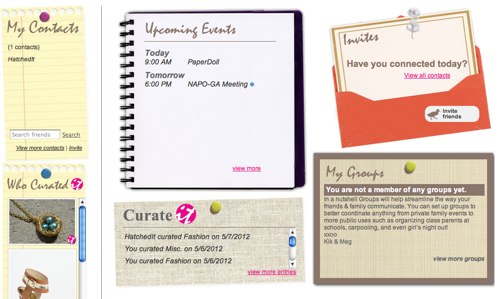
Calendar — Add events or tasks just as you might do in Google or Outlook — just select the event name, date, time, whether you want a reminder and any additional information. However, while events can be scheduled as repeating, tasks cannot, and scheduling is not particularly sophisticated. For example, you can’t schedule an event specifically for the second Tuesday of each month, and the system requires you to schedule an end date, even if your recurring event does not have one, which might cause hiccups unless you mark an end date in 2025.
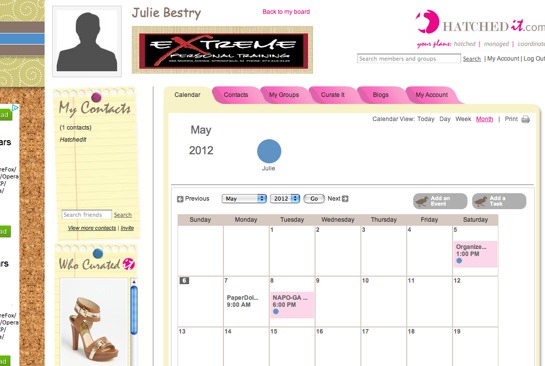
Grant everyone in your immediate family (i.e., those you specify as members of “My Account”) access to view the family calendar. Each member has his or her own log-in and password. Then you can choose if you’d like to allow other, specific, members of HatchedIt to see select categories on your calendar. For example, you might give grandparents access to see all sporting events or school events, but not items related to your work schedule.
Contacts can be uploaded from Yahoo, Gmail, Mac iAddressBook or Outlook directly into the system or you can input individual names. Anyone to whom you grant any viewing access will be designated as part of your circle.
Groups are designed to work like real-life groups — members of your book club, other PTA parents, etc. HatchedIt envisions Groups as a way to have a private, central location for sharing information and discussion.
Curate It is a place to hold important photos, articles and information. Think of it as an in-HatchedIt Pinterest board, though curated pages need not be reciprocally or publicly shared. Tag items for easy categorization in five classifications: family, home, love, fashion or miscellaneous.
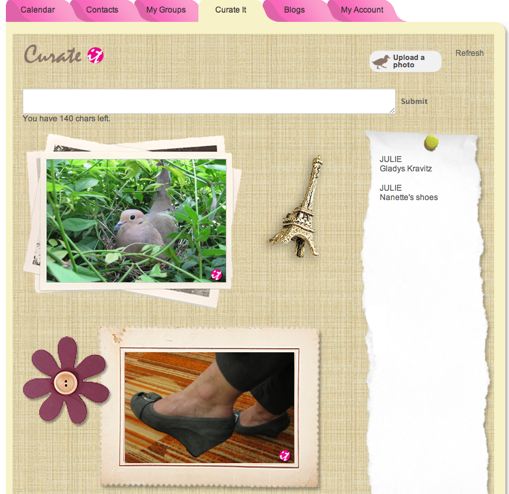
Blogs — HatchedIt has a built-in RSS reader to make it easy to keep up with your favorite blogs and news sources. HatchedIt pre-loads some feeds and you can add any of your own favorites.
Default settings are always set to Private, and privacy is very granular, such that you could give access to only your Curate IT page and not your Calendar, or only specific calendar categories.
When you add family members to your account, you designate each member’s rights to view and/or edit parts of your family’s account (so your web-savvy six-year-old doesn’t cancel all piano lessons). You can always adjust these permissions later, but any HatchedIt member designated as a child will only be allowed to interact with members of the family account.
The ability to gather all of this information in one central location, with multiple adjustable privacy settings, should appeal to parents. However, I was concerned that the calendars cannot sync with other calendar systems. I must admit, as one who prefers slightly more sophisticated technological tools, it seems more like a training wheels system more ideal for someone who isn’t particularly comfortable with technology.
For my purposes, separate email accounts, private Facebook groups, RSS feeds and Pinterest boards (or a private board on a Pinterest alternative site) would be adequate, as I generally prefers separate tech solutions to modular solutions under one umbrella. However, as a non-parent, I don’t have the wide variety of interacting family contacts and activities to juggle. Plus, my NAPO colleagues voted HatchedIt as Organizers’ Choice for Best Tech Product at this year’s conference, so I encourage you to test it out.

AboutOne is like a digital filing cabinet for keeping track of all your important documents, information and memories. The system has an easy, fun set up where you merely click people-shaped icons and input the names of adults, kids and pets in your family.
Records — Visit the Organization Station, the central hub of AboutOne, to fill in fields, as appropriate, for each record you wish to add. (Later, you’ll click the Add button on the site’s dashboard.) Provide a title, location, date, time, description, and add attachments (like photos, videos or files). For any item, select up to four categories under which the entry can be concurrently filed:
Memories (Photos, Quotes, etc.)
Health Info
Possessions (Home, Car, Inventory, etc.)
Education or Training
Attach photos, videos or files, like scanned insurance policies, medical records or home inventories, and if there’s an associated web site, like a purchase page for your new car or the Facebook update for a big event, you can link the entry to that URL.
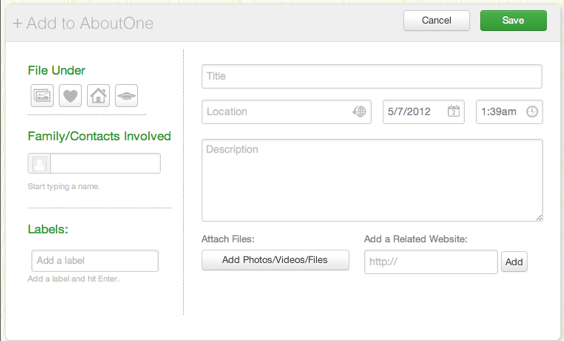
So, if Billy lost his first tooth on 5/8/12 at 4 p.m. at Friendly’s, you’d enter that information as a Memory, and then attach a photo of his toothy, toothless grin. Similarly, if you bought an iPad, you’d fill in the pertinent information and then scan, upload and attach the receipt and the AppleCare policy.
The screen also lets you pick family members or contacts related to the entry, and add a label, like a tag, to improve searchability. So, if you buy an auto insurance policy, you can link the contact information for your agent to the scanned-in policy.
To search records, just click on the categories (Memories, Health, Possessions or Education) in the dashboard’s left-side menu and select what you wish to view, either from a list or a card (like little square sticky notes lined up in a grid pattern). There’s also a menu item for Stream, to simply view everything, in case you can’t remember how you categorized or tagged an entry.
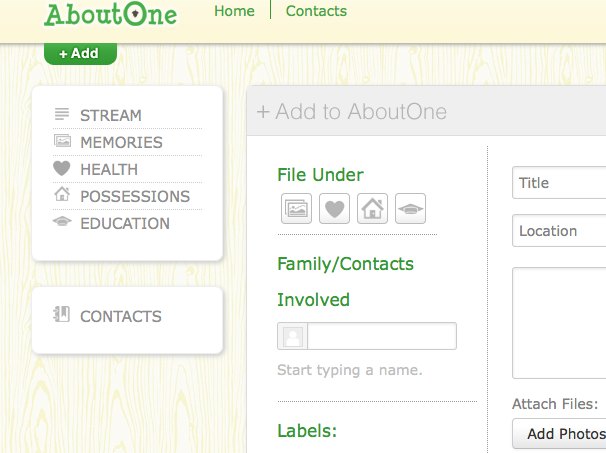
Contacts — Import from Gmail, Outlook and other contact systems, or directly input any individual’s essential information, like phone, email, physical addresses, and social media profiles (including Twitter, Facebook, LinkedIn, Google+ and Skype). Add tags for categorizing contacts.
You can also create groups from your contacts, so you can easily access, for example, all of your physicians, your home improvement team (contractor, decorator, professional organizer) or your financial team (bookkeeper, accountant, insurance agent, attorney).
Shareables — Once you enter data, AboutOne can manipulate the information to provide a wide variety of lists, updates and reports. For example, once you enter birthdays and anniversaries, you can create a gift log for recording gift ideas, as well as gifts given and received, and be reminded of important dates.
There’s an online scrapbook to which you can add “multimedia memories and milestones” simply by emailing from your smart phone or scanning directly to your account. Each memory is automatically timestamped, so you don’t have to remember when something happened. Paper Doll particularly likes that you can easily pull from the Memories section to format a printable or email newsletter to keep people up-to-date on your family.
Other Shareables include babysitter instructions, health history reports, and caregiver reports. When kids are applying to college or for scholarships, the organized records can help them create education histories and volunteer summaries. You can create home maintenance summaries to share with prospective buyers, and the system can even calculate your capital gains at tax time.
AboutOne currently has no calendar, but a sync-able calendar system, with emailed reminders and historical records, is planned. Up to 2 GB of storage is free; premium paid plans will soon be available.
AboutOne’s system is relatively intuitive. However, at various points in the data entry process, users are offered social gaming-style points and badges, which I found distracting. Nonetheless, I can see how some users might find this motivating to help discourage procrastination.

Organizables is a remedy for morning chaos in households with kids. Every busy parent knows what it’s like to try to get children dressed and out the door each morning. Professional organizers often suggest easing morning tensions by helping kids select their next-day’s wardrobe the night before. In some homes, we even advice selecting a week of outfits and setting them in a drawer or hanging sweater organizer.
Of course, there are other times when planning can hit snags — when trying to pack outfits for sleepovers at Grandma’s, or when parents have shared custody, and even when kids need outfits packed up and ready to wear for recitals or other special events.

Organizables has created child-sized hanging garment bags for boys and girls. Each weekday set includes five Monday-Friday bags, each with pockets for socks, underwear and accessories. The clothes stay clean, dry and wrinkle-free, even on travel days, while parents and kids can enjoy the relative serenity of calm mornings, where every essential is ready and available in one tidy package. And there’s even a customizable daily checklist to make sure everything makes it into the hanging bag!
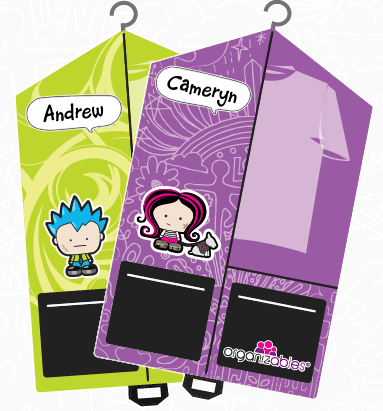
The weekend sets are designed for on-the-go kid activities — each set has a Saturday and Sunday hanging bag (for everyday activities and/or going to a house of worship or family event) and two zippered activities bags (like for ballet lessons, sports or sleepovers) also with bright graphics. Since the latter are more likely to be used outside the child’s main home, they can be customized with the child’s name, favorite saying or key word.
Organizables bags are printed on durable, lightweight, water-repellent material with zippered storage compartments, and boldly labeled with each of the days of the week. They’re made with durable, non-toxic materials and comes with a one-year warranty. Sets are available with or without the cute graphics, in case older kids prefer a little more subtlety.

On a related note, I fell in love with one item from NeatFreak!’s NeatKids line. The cabana-esque Whimsical Wardrobe, available in either Candy Taffy (shown below)
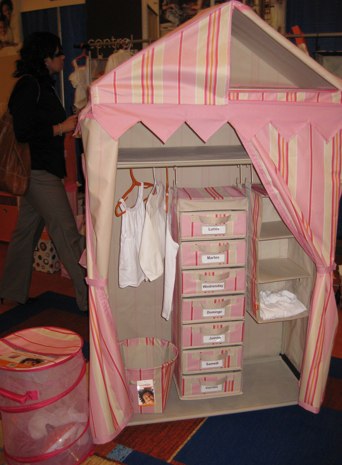
or Pop Rocks (a more neutral, boy-friendly) is a perfect stand-alone wardrobe for hanging clothes, folded dresser items and toy storage. It’s adjustable and customizable, and just so darned cute, that I have to admit that I’d like one of my own. (Paper Mommy, are you reading this?)
Happy Mother’s Day!
NAPO Expo 2012 Recap (Part 4) — New Twists On Old Favorites
This year, three products particularly caught my eye because they offered something comfortable (high quality, for example, or proven concepts), twinned with something novel (either visually or functionally). They’re things that make you say, “Oooooh!”
BOXES FOR THE HOME BANKER
As we’ve discussed previously, Bankers Boxes aren’t the stuffy file boxes they used to be. Fellowes has made some nifty strides in modernizing what used to be a product for simply boxing up documents. Nowadays, they’re a snap to assemble, have internal dividers to keep papers from getting squished or falling over, and can come complete with internal file rails to make use of hanging folders. Bankers Boxes even come in fashionable colors and are made from environmentally-friendly recycled materials.
So, I suppose I shouldn’t have been surprised when I came across the Bankers Box display at the 2012 NAPO Expo, but I have to say, I did a double-take.
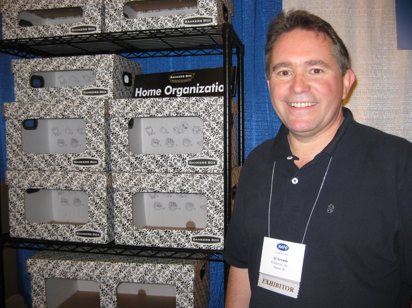
Fellowes Representative Al Arends with a New Expo Star
I’m pleased to report on the new Bankers Box Home Organization Stackable Storage boxes. Most notably, as you can see in the photos above and below, the new boxes are PRETTY! A classy black and white brocade pattern makes them attractive enough that one needn’t feel the obligation to hide them in the basement, attic or the back of a closet. These boxes would not be amiss sitting on shelves in a home office, bedroom or craft room, and one wouldn’t want hide them away if unexpected company were to arrive.
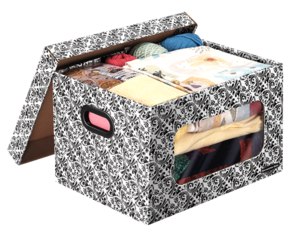
Each lidded Bankers Box Home Organization Stackable Storage box has:
–A large vertical window to make it easy to identify the contents stored within
–Heavy-duty double-wall or triple-wall construction to make the boxes sturdy enough to stacking and long-term use
—Sturdy, reinforced plastic handles that snap into place, easing lifting and carrying, and maintaining the structural integrity of the box
–Patented FastFold design which allow for easy set-up without glue, tape or complicated instructions
In addition, all of the Bankers Box Home Organization Stackable boxes fold flat when not in use, helping you maximize storage space. Because of the heavy-duty construction, you can use, fold flat and reuse the boxes with minimal impact or wear. Fellowes designed the stackable boxes to fit standard-sized shelving:
- Small Stackable: 6″ high x 12″ wide x 15″ deep
- Medium Stackable: 10″ high x 12 wide x 15″ deep
- Large Stackable: 10″ high x 15″ wide x 24″ deep
The Stackables are suitable for storing memorabilia, non-archival photographs, school papers, craft projects, baby blankets, and so on — whether you’ve got paper, clothes, home dcor or whatever, you can bank on this solution. (C’mon, you’d have used that pun, too!) They’re sold four to a package.
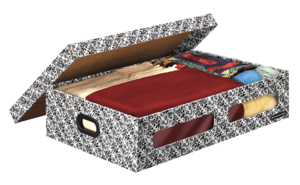
There’s also a Small Underbed box, with the same features (though not designed for stacking) measuring 6 1/4″ high by 17 1/2″ wide by 27″ deep. The underbed boxes come two to a package.
Fellowes is also manufacturing a line of Holiday Stackable Storage boxes. The green-lidded, red-bodied boxes have many of the same features as above: a large, clear plastic window to view contents, easy FastFold set-up, heavy-duty construction and the ability to fold flat. However, instead of snap-in handles, the holiday versions have built-in plastic handles and a multi-level design with adjustable dividers for protecting delicate ornaments.
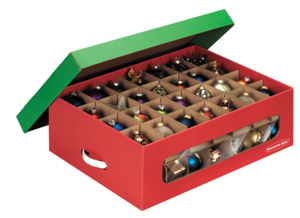
The Large Ornament Box measures 8″ high x 15 1/2″ wide by 23″ deep and is sold in packages of two.
Bankers Box Home Organization Stackable Storage boxes can be purchased at Staples, Office Depot, Office Max, Walmart and Sam’s. To see how the boxes come together and fit ideally into your home, take a peek at this video.
GET MAGNETICALLY ATTRACTED TO YOUR TASKS

Abundance Organizing, a company run by five professional organizers, had a nifty display of organizing products at the 2012 NAPO Expo, none more captivating to Paper Doll than the magnetic task organizers called Pile Tiles™. Each of the colorful, cloth-covered magnets is coded with a large letter standing for an associated task or category.
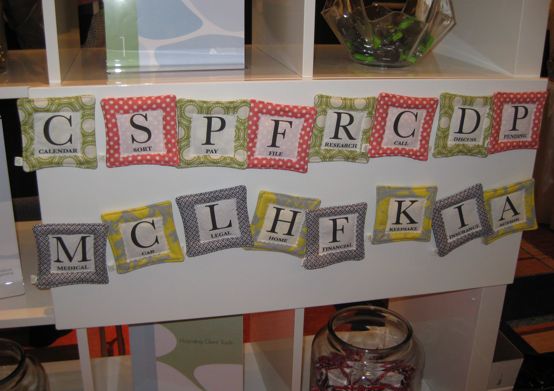
At first glance, Pile Tiles™ may merely seem adorable, but they serve an important organizational purpose. First, they can be used in a traditional manner to help sort papers and hold them down (to protect against a wafting breeze); instead of using sticky notes or index cards, these re-usable darlings are environmentally-friendly and charming to behold.

But not everyone has the space or the inclination to pile up or spread out papers to sort them. By making use of magnets (and a spare refrigerator, metal door or even hanging baking sheet), you can easily sort and hang papers vertically, without the need for paper-poking pushpins or a bulletin board.
In either respect, Pile Tiles™ are perfect for visual learners and they add a delightful decorative note, allowing you to feel good about leaving your papers out even when company arrives.
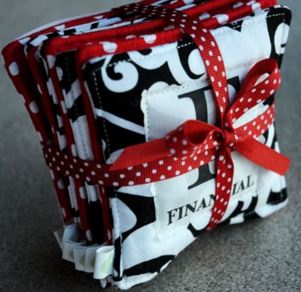
- The Starter Set categories are: Financial, Legal, Medical, Insurance, Home, Car, Keepsake and Action.
- The Action Set includes: Calendar, Call, Discuss, File, Pay, Pending, Research and Sort
The Starter Set of Pile Tiles™ is designed to help you initially sort your papers. Once your piles are organized, the Action Set is focused on helping you tackle individual tasks, like phone calls, scheduling, and paying bills. Each set sells for $39.
(Special thanks to organizational product maven Jeri Dansky, who made sure I hightailed it over to the Abundance Organizing booth to see the Pile Tiles™.)
BOXING UP THE PROJECTS
Certainly, between file folders and three-ring binders, paper peeps haven’t been at a loss for products to contain their papers. But Smead’s My Organizer (MO) System has three elements that replace the need for hanging folders and binders, while still promising to keep project paperwork collated, tidy and vertical, whether on your desktop, shelved, or tucked away in file drawers.
The MO Kit has three basic elements:
1) MO File Cases — Each file case is a sturdy snap-open, fold-into-place, flat-bottomed file box capable of holding up to 750 sheets of letter-sized paper. The File Case fits most standard file drawers, including those with hanging file rails already in place, or can be easily placed vertically (narrow edge outward) on bookshelves.
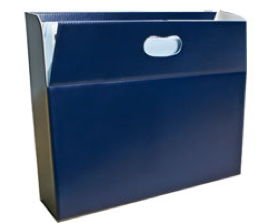
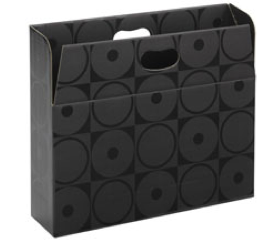
The file cases are envisioned for sub-dividing categories of documents or individual projects, but can also be used as small desk-top file boxes for action or quick-reference items. Die-cut handles make the open-top file cases easy to lift out of file drawers and transport to meetings or events.
The cases come in Navy and Black Circle designs (as shown above), as well as in Moss Circles, similar to the black pattern above, but in a creamy beige and moss green.
2) MO Kits — Each kit includes standard letter-size SuperTab file folders, pre-printed and blank labels, and an easy-to-follow instruction sheet with organizing tips for starting common projects, like taxes. Options include Medical, Financial, Project and Starter kits. Because the file folders are standard, they can be used within the MO File Case, or, as necessary, in standard hanging folders.
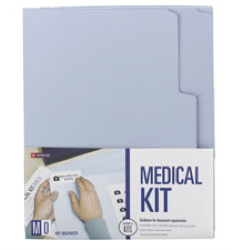
The MO Kit file folders come in three colors: Camel, Moss, and Light Blue, while the oversized, SuperTab-ready label templates are keyed to the individual kit types:
Projects — with label templates for budgets, contracts, expenses, invoices, etc.
Medical — with labels for medical history, dental procedures, insurance claims & EOBs, receipts and HSA records, etc.
Financial — with templates for bank statements, tax information, investment records, charitable contributions, etc.
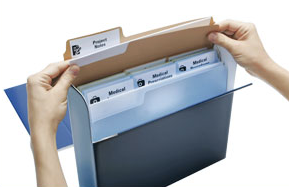
3) MO Case Wraps — Available in Navy, Black Circles and Moss Circles to match the case files, the MO Case Wraps, as noted by Smead, “provide security and discretion for important files and hold documents securely for easy storage.”
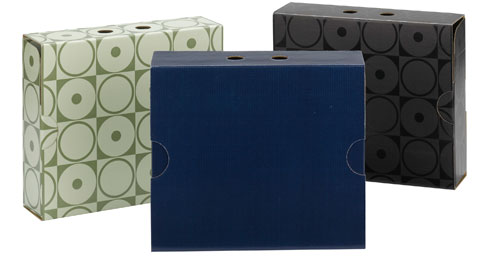
Made from durable, professional-quality corrugated paper, the Case Wraps are designed to pack flat, “pop open” into shape and stand up to heavy usage. Top die-cut holes and side die-cut half-moons provide easy access for sheathing/unsheathing the cases without pinching or paper cuts.
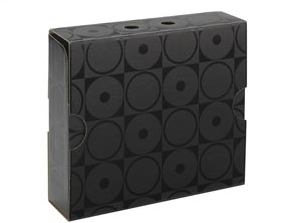
The MO system offers a secure, attractive, streamlined alternative to hanging folders or binders. Use the kit folders to sort the essential documents of any project — tax records, trust documents, divorce paperwork, etc. Gather the kit folders in a File Case to keep vital papers together. Finally, for your 007 Super-Top-Secret documents, wrap it all in a Case Wrap for extra security, preventing files from falling out and non-essential documents from being mistakenly tossed in.
Next week, we’ll close up our tour of the 2012 NAPO Expo with some mom-themed organizing resources — just in time for Mother’s Day.
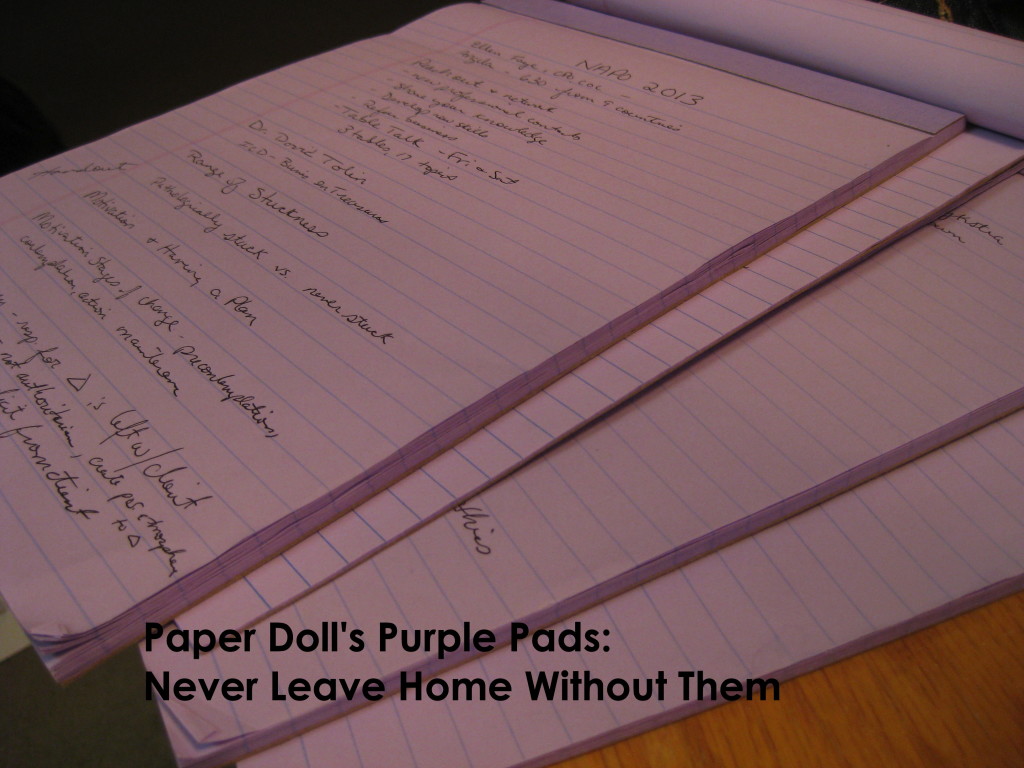
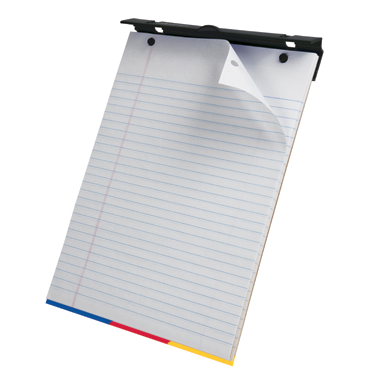


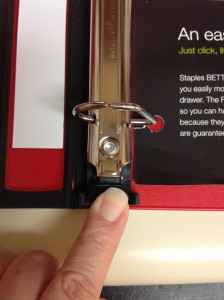
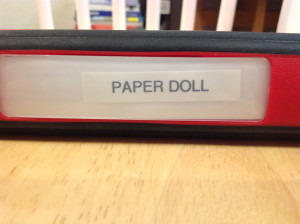
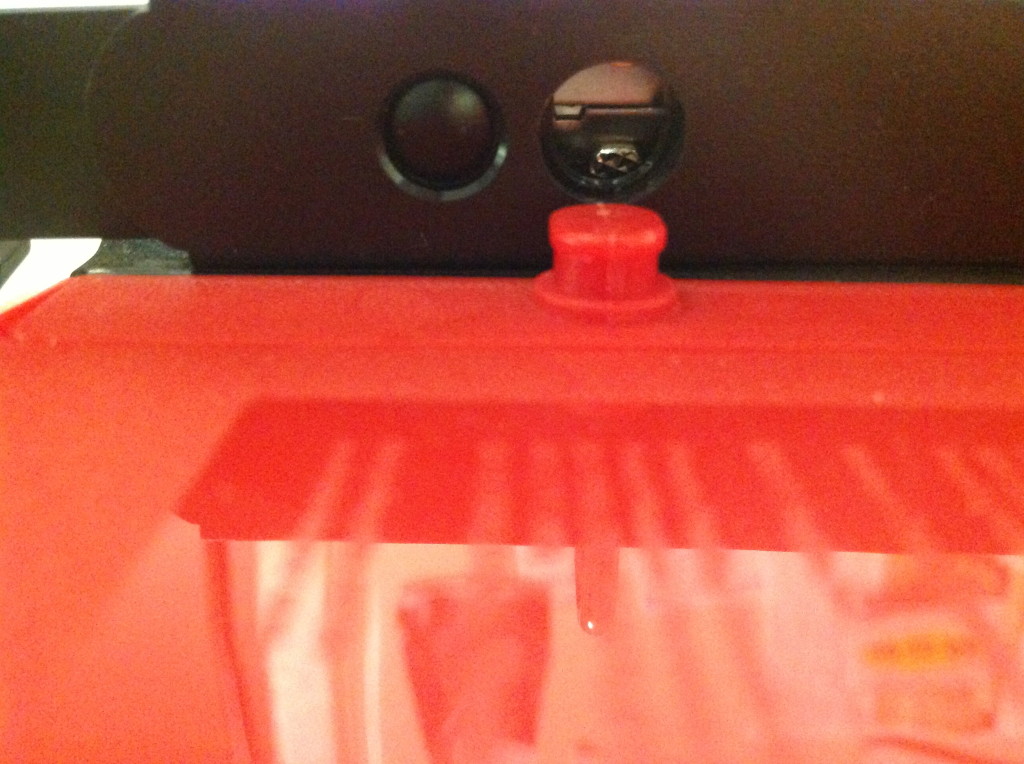
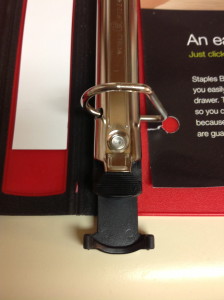
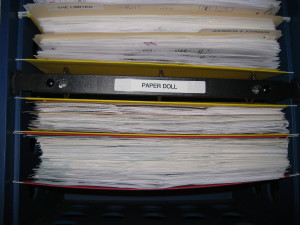


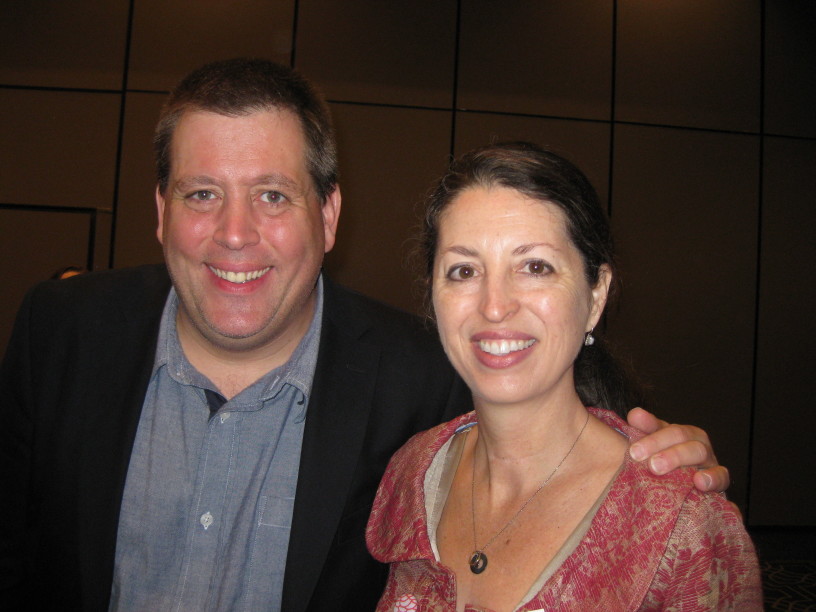

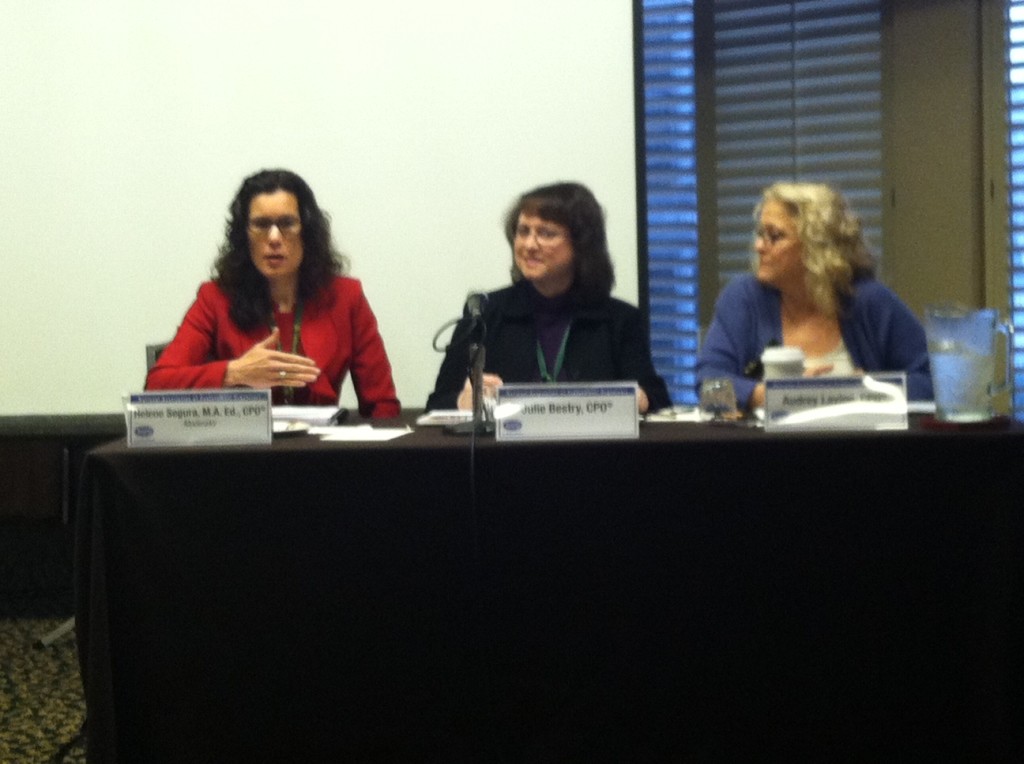

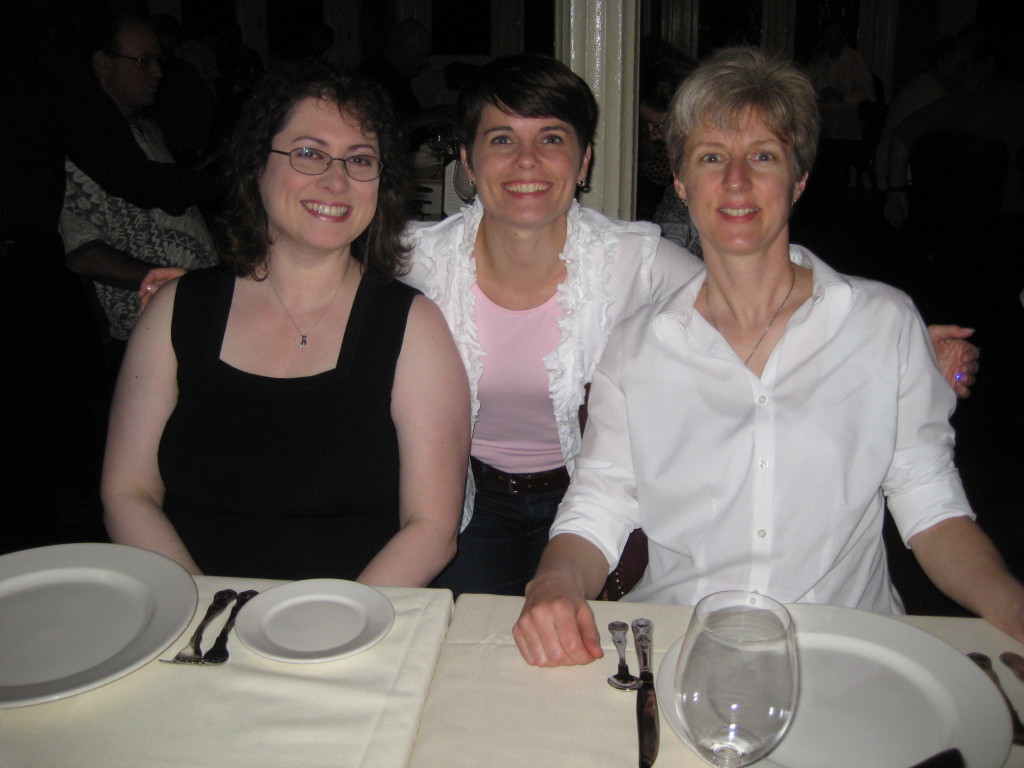
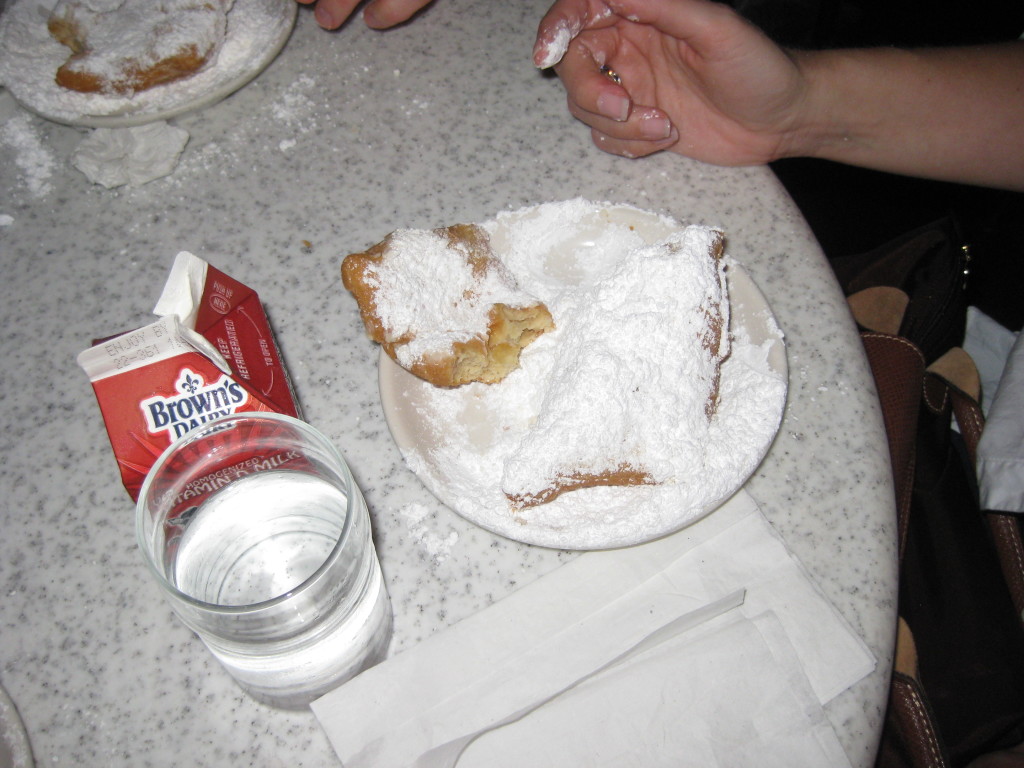



Follow Me